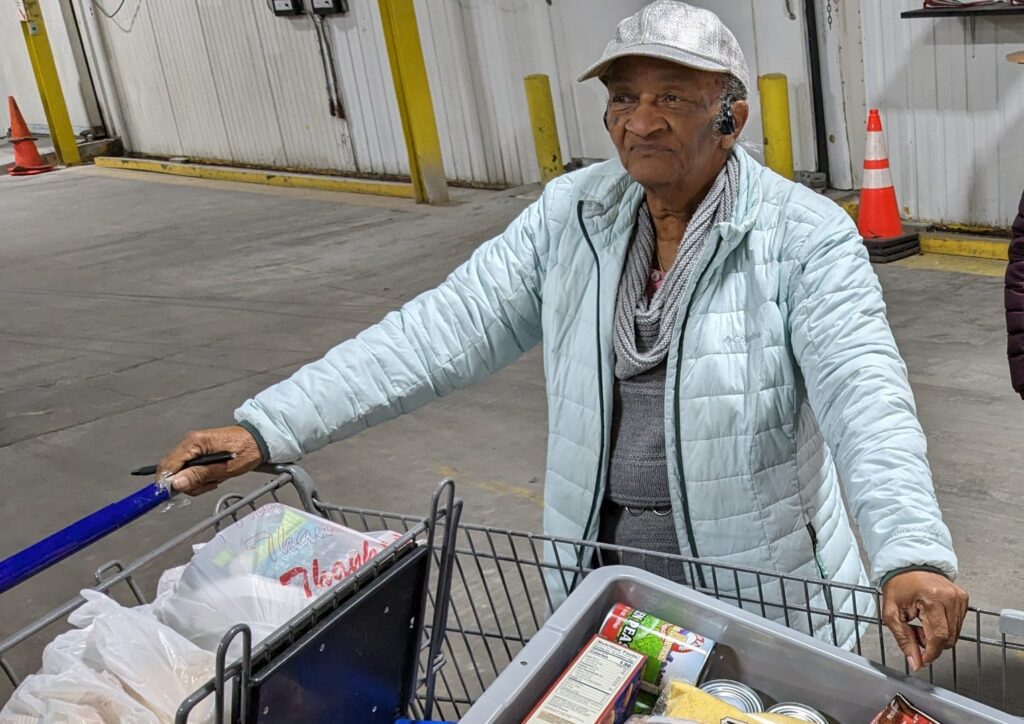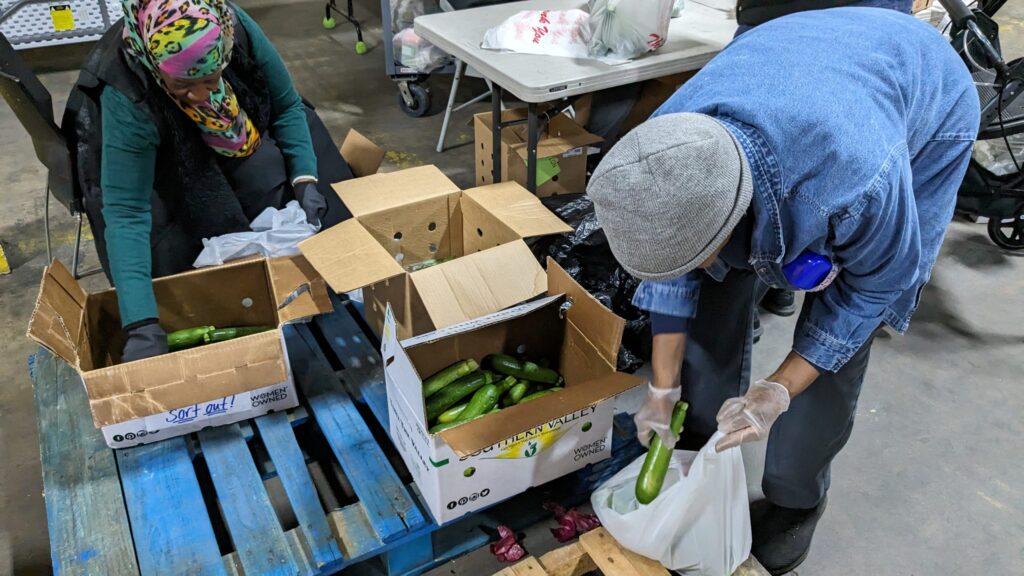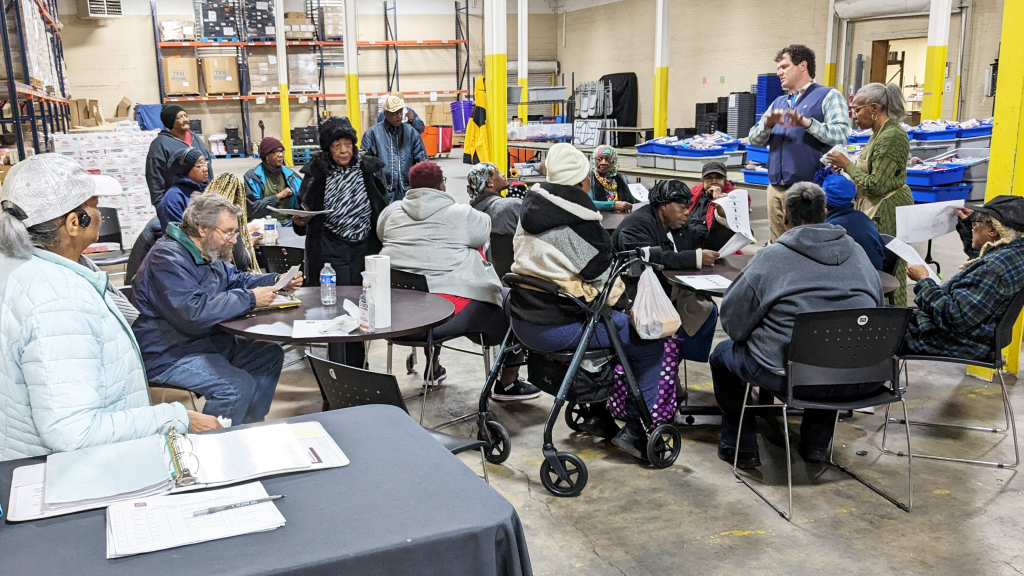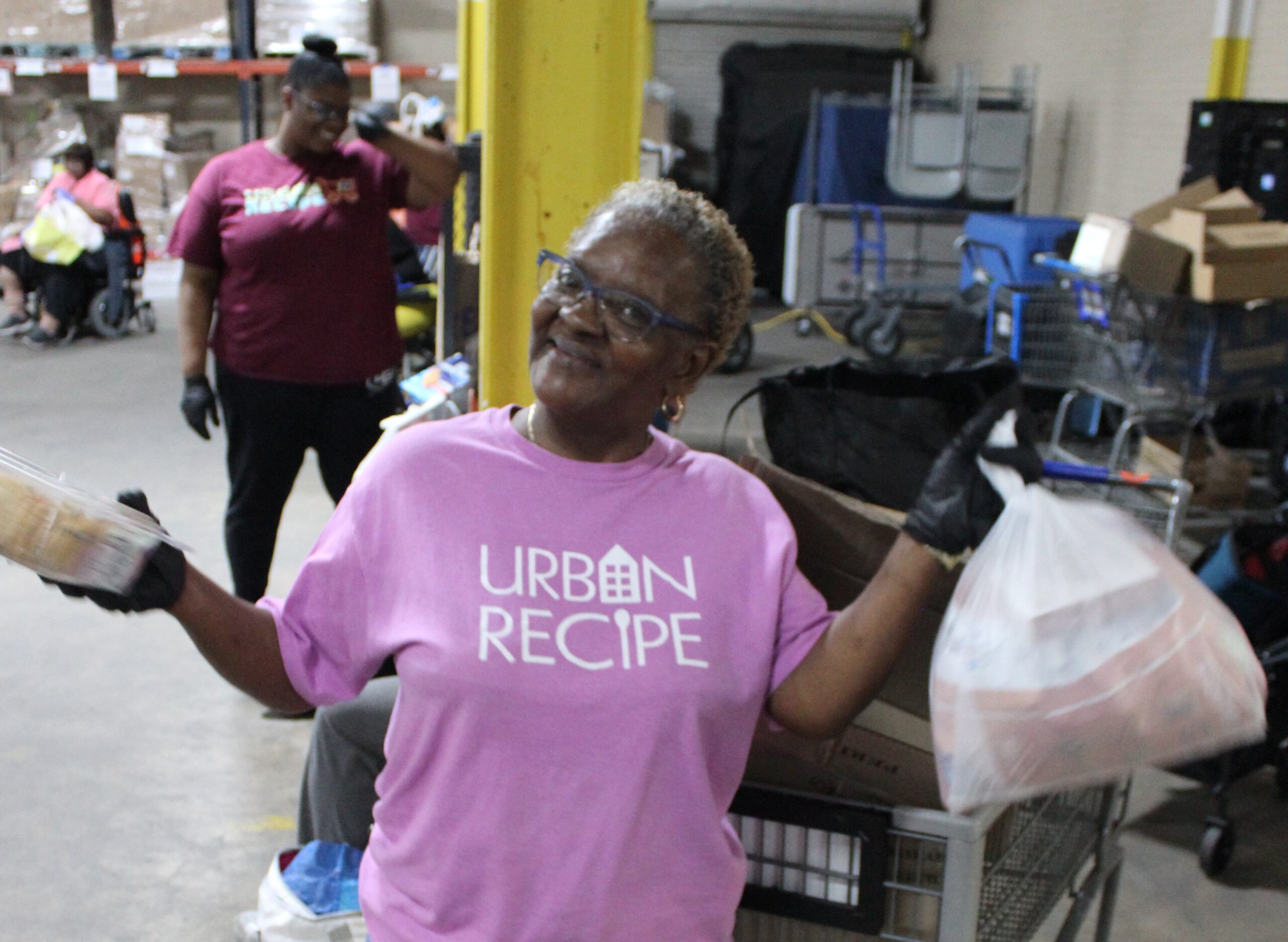It is 10 a.m. on a Monday morning, and the warehouse at 970 Jefferson Street in Atlanta is humming with activity. A forklift loads a pallet of cereal boxes. Two men are setting up a line of folding tables. Several people casually sort a box of bananas into grocery bags. Fog escapes from a walk-in freezer as someone rolls a dolly filled with boxes toward the line of tables. Five or six people walk in from the bus stop with rolling grocery carts. In the center of the bustling warehouse, JoAnn Crowder stands behind a desk with her clipboard, quietly orchestrating the hustle.
For the last 24 years, JoAnn has spent almost every other Monday morning here. She is the longtime secretary of Co-op 1, a food co-op facilitated by Atlanta-based nonprofit Urban Recipe. Every other week for the past 34 years, folks facing food insecurity have gathered to sort, organize, and distribute food amongst themselves. Unlike a traditional food pantry, those receiving food assistance are members of a co-op that governs itself democratically
“I originally heard about the co-op from a friend who was a member, and I was just interested in the free food,” Crowder says. “Pretty soon, this co-op became my family. It’s something to do. It’s my reason for getting up in the morning, all of us helping each other out,” she adds.
JoAnn is not alone. Many of the 50 families in Co-op 1 have been members for more than 10 years, including the co-op’s president, Canveta Burke. Ten years ago, she became a foster parent for a relative’s children. Suddenly, she was a single mom on a limited income with eight children to feed. She didn’t like the feeling of going to a traditional food pantry but could not afford to feed her suddenly full house. In those early years, the food co-op was a lifeline for her family. After years as a member of the co-op, Burke decided to run for president two years ago as a way to give back and to be a voice for other members to share their concerns.
“When people join a co-op, it’s often initially just to fill a gap in the food supply,” says Urban Recipe executive director Jeremy Lewis, “But over time, the co-op is really meeting a need for food, yes, but also a need for community, for personal growth, for accomplishing a shared task together.”

JoAnn Crowder with grocery cart full of food
Co-op 1 secretary JoAnn Crowder. Photo credit: Bobby Jones
History of food charity in the US
For low-income Americans facing food insecurity, food banks and food pantries are often a necessary lifeline. Many low-income families rely on government assistance programs like the Supplemental Nutrition Assistance Program (SNAP, also known as food stamps) or Special Supplemental Nutrition Program for Women, Infants, and Children (WIC) to meet their food needs. Not all families can access SNAP or WIC due to immigration status, draconian income and asset requirements, onerous paperwork requirements, the “time tax,” and work requirements in some states. For families who can access food benefits, the average monthly SNAP benefit was just $181 per person and $343 per household in April 2023 according to the Pew Research Center—hardly enough to ensure stable food security for an entire month.
Food banks and food pantries fill in the gaps for families facing both short-term and long-term food insecurity. While they may appear to be a permanent facet of American life for those living in poverty, the St. Mary’s Food Bank Alliance in Phoenix, AZ was established as the world’s first formal food bank in 1967.
Early food banks were not established just to feed the hungry. Food banks and pantries are an essential part of an inefficient commercial food system that results in 30–40 percent of all edible food being wasted, according to the USDA. The vast majority of food donated to US food banks comes from grocery stores and government sources, with some estimating up to 80 percent or more. Food banks and food pantries provide food assistance to low-income families by exploiting the inefficiencies of a commercial food system built for profit over people.
The US now has more than 200 food banks serving over 40 million people annually according to, Feeding America, a national organization for food banks and the second largest charity in the country. In the US, most food banks consist of a centralized warehouse that distributes food through a decentralized network of food pantries, community centers, and churches across a city or region. Those decentralized food pantries are where most low-income people actually interact with this vast system of emergency food assistance.
The problem with food pantries
Canveta Burke describes her food co-op experience as “food with dignity.” That phrase gets repeated by food co-op members and Urban Recipe staff over and over again because the alternative—the experience at the average US food pantry—can often be a trade of food for dignity.
Thanks to a culture of individualism and “pulling yourself up by your own bootstraps,” asking for charity or social services is often a fraught experience in the US. Beyond the internal shame or embarrassment that can accompany seeking food assistance, many food pantries operate under a charity model that removes the agency and dignity of those seeking help.
In fact, many food pantries impose a lengthy application or referral process with multiple forms of income verification, long wait times, limited and inconvenient hours, periodic recertification of bureaucratic hurdles, and transportation challenges.
Additionally, most traditional food pantries limit the choice and agency of folks receiving assistance. Although some food pantries have adopted a “choice pantry” model that allows for some choices of different food options, most food pantries still distribute a pre-packaged box of whatever is available from the food bank that week with little or no input from the recipients. Rules established to ensure fair distribution can impose limits on the choice and amount of food, which can be disempowering and dehumanizing for those receiving assistance.
Even the food pantries that take proactive steps to mitigate the bureaucratic barriers that plague the worst food pantry experiences often still operate under a charity model rather than solidarity. Food pantries that allow recipients to “shop” for the food they want still create passive, transactional relationships with those experiencing food insecurity.
I can do things you can’t do. You can do things I can’t do. Together, we can do wonderful things!

Canveta Burke
Co-op 1 President

Co-op 1 members sort food. Photo credit: Bobby Jones
The Urban Recipe model
Co-ops at Urban Recipe are anything but passive and transactional.
“Urban Recipe started in 1991 out of one church’s efforts to be in relationship with their community differently beyond the traditional food pantry relationship,” executive director Jeremy Lewis says. Urban Recipe has moved out of that church and now operates and facilitates six food co-ops similar to Co-op 1 and helps operationally support and source food for four additional co-ops in Atlanta that have been through their cooperative pathways training program.
Their model is rooted in cooperative principles, so decisions are made collectively and leaders are elected democratically in each co-op. Co-op members collectively decide the specifics of how food is equitably distributed, who does what jobs, how to handle extras or unwanted items, and how active a member has to be to maintain co-op membership.
Each democratically elected co-op board regularly solicits input on what type of food they request from the food bank. For example, one co-op located at a senior apartment complex gets regular deliveries of nutritional shakes like Boost or Ensure, while another co-op at an elementary school gets lots of pre-packaged snacks for kids. Before the Shareable team visited, Co-op 1 even voted on whether we were allowed to come and if we were allowed to take photos while we were there.
In stark contrast to most food pantries, Urban Recipe’s role is basically ordering food and equipping and training members for success. Co-op members are not passive recipients of aid—each member is integral to the operations, from sorting and distributing food to making crucial decisions about the co-op’s functioning.
“It’s really important that there’s always a role for everyone,” adds Lewis, The co-op is a reminder that everyone has a role, gifts, and abilities that often go unrecognized for people living in poverty. Given the space, those abilities can come to life in the co-op.”
New members go through an orientation and are usually paired with a seasoned member to learn the ropes, ensuring everyone knows how to contribute effectively. Some co-ops require all members to learn how to do all jobs while others let people specialize in the jobs they prefer, and even co-op members with limited mobility have a role to contribute.
After about an hour of sorting, organizing, and packing a mix of shelf-stable foods, fresh produce, frozen meat, and other foods, Co-op 1 holds its bi-weekly meeting. Announcements are made, concerns are voiced, and co-op president Canveta Burke leads the group in a chant: “I can do things you can’t do. You can do things I can’t do. Together, we can do wonderful things!”
With that, co-op members line up in the order they arrived (Co-op 1’s distribution policy to help ensure everyone arrives on time). Each member wheels a shopping cart full of food out of the warehouse to their car or rolling grocery carts to make the trip home.
In stark contrast to most traditional food pantries, some members talk about where they are going to deliver some of the food. While most food pantries put up barriers to ensure food goes to the “deserving poor,” Urban Recipe actively tracks how many co-op members are able to share food with other family, friends, and neighbors. In 2018, 62 percent of all co-op members reported sharing food each month, compared with 29 percent before joining their co-op.
Urban Recipe’s model is a powerful testament to what’s possible when we reimagine food assistance through the lens of solidarity. By putting decisions into the hands of the very people it serves, this cooperative model transforms the traditional food pantry into a vibrant community where dignity and mutual aid replace charity and dependence.
Members don’t just receive food; they gain a voice, a role, and a support network that extends far beyond the distribution line. This approach challenges the traditional food charity model and offers a blueprint for building stronger, more resilient communities grounded in cooperation and shared responsibility. As Co-op 1 chanted at the end of their meeting: everyone has something to offer. By tapping into those gifts through cooperation, together we can, in fact, do wonderful things.



